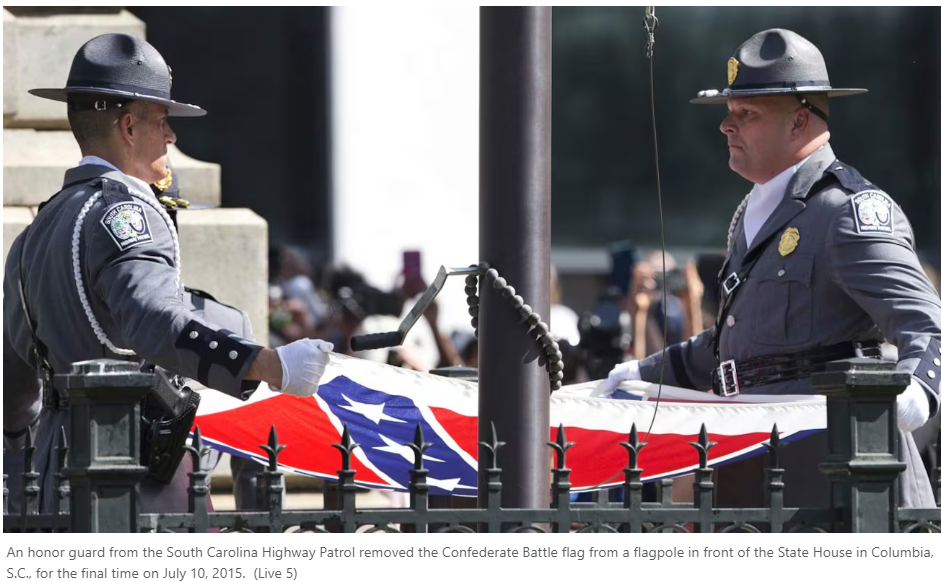MOBILE, Ala. — Step onto a Civil War re-enactor’s battlefield and you’ll be surrounded by grizzled, mustachioed soldiers smoking cigars and wielding dangerous-looking period-style weapons. Take a closer look, and you’ll realize some of those same soldiers are women.
Whitney Hamilton has been re-enacting for 11 years, and has become a pro at passing for a man once she dons Confederate gray.
“When I did my first re-enactment in Gettysburg in 2003, I never did see another woman in the group,” Hamilton said. “I’m pretty good about being able to pick them out. I was told that if anybody asked me if I was a woman that I would get thrown off the field.”

Whitney Hamilton of Brooklyn, NY, portraying a 6th Alabama Calvary sailor, right, talks with Kaye Stevenson of Montgomery, Ala., before battle at Fort Gaines on the third day of the 150th Battle of Mobile Bay commemoration in Dauphin Island, Ala., on Sunday August 3, 2014. (Sharon Steinmann/ssteinmann@al.com)
Hamilton became interested in re-enacting after writing a play on Joan of Arc, when the idea struck her to write a similar story about a woman in Civil War times. She eventually joined the 6th Alabama Cavalry, which welcomed her with open arms.
“We’re trying to honor our ancestors and the sacrifices that were made, and I have never seen what was wrong with women in this day and age who wanted to do the same thing,” said Brien McWilliams, commanding officer of the 6th Alabama Cavalry.
For Laura Dothard of Nances Creek, also with the 6th Alabama Cavalry, re-enacting is a way to keep in touch with her heritage.
“I have several ancestors who fought for the Confederacy,” Dothard said. “I’m doing it in honor of them.”
Dothard wanted to start re-enacting about 25 years ago, she said, but encountered companies which wouldn’t allow women to portray soldiers. She joined McWilliams’ group three years ago, and has found it a very positive experience.
“I actually don’t know if they (audience members) even know (that some of the soldiers are female), but they cheer us on just like they do the guys,” Dothard said. “If they know that we’re women I think they cheer us on more, because we’re doing such a hard thing. I have never had anything negative said.”
For Karen Propst of Bay Minette, re-enacting is a way to bond with her 13-year-old son, Michael Olson.
“He and I were able to fight shoulder to shoulder,” Propst explained. “When we were getting commands, I could tell him (how to do things). It made it easier for him, learning.”

Karen Propst, of Bay Minette Ala., portraying a 6th Alabama Calvary sailor, sits in the barracks before battle at Fort Gaines on the third day of the 150th Battle of Mobile Bay commemoration in Dauphin Island, Ala., on Sunday August 3, 2014. (Sharon Steinmann/ssteinmann@al.com)
Propst and Olson both re-enact with the 6th Alabama Cavalry, and participate in cowboy re-enactments as well as Civil War battles.
“I’ve never come across any prejudice while I’ve been doing this,” Propst said. “Everyone in every unit has done everything in their power to help me further myself and better myself in the hobby.”
When it comes to women in the ranks, the South tends to be more progressive, Hamilton explained.
“Most of the Southeastern or Alabama division is a lot more tolerant of women that fought because they do know the history,” Hamilton said. “But the further you go north, the more really strict they are, especially in New York state and Pennsylvania.”
When she first started re-enacting, Hamilton put on a fake mustache and beard as a way to blend in and avoid confrontations about her sex. Now she continues that practice to get into character, and teaches other women how to do the same.
“I’ve actually taught other female re-enactors who want to do an authentic impression what to buy and how to apply it so it looks real,” Hamilton explained.
After dragging her husband Patrick Sullivan into re-enacting 10 years ago, they’ve fought side by side on historical battlefields ever since.
“People are impressed with the fact she can pull it off so well,” Sullivan said. “There have been some interesting times with certain people — just seeing their reaction to it is pretty cool.”
The Brooklyn-based couple runs Bjornquist Films together. It’s a production company putting out micro-budget features with an emphasis on historical films. In 2005, they put out “My Brother’s War,” a short film about a woman who joins the Confederacy disguised as her brother. They’re currently working to get funding for “Union,” a longer film following the same woman.
Still, Sullivan said, he has to draw the line somewhere.
“With the mustache and the goatee, I’m not going to give (her) a kiss,” he joked.
Re-enactors, like these women, highlight an important point about the Civil War, McWilliams emphasized.
Hamilton’s research for historic films found that more than 400 women fought disguised as men, both for the Union and the Confederacy.
“It is historically correct because there were women who did serve,” McWilliams said. “Quite a few of them actually drew pensions after the war. They escaped — they made it through the whole way.”
While these re-enactors can wield rifles and muskets side by side with their male compatriots, they’re just as capable in the ballroom as on the battlefield.
“I also portray a lady,” Propst said. “I do have the dresses and all of that, and I do the Southern Belle, the Victorian lady as well. But during battle time, I enjoy getting out.”
-Glen Luke Flanigan, al.com


